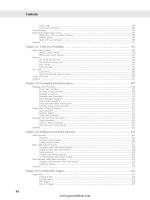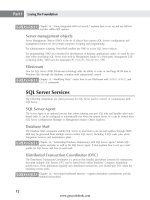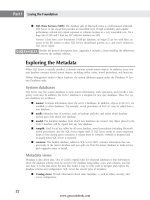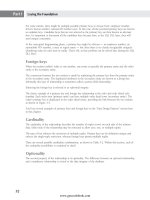Hướng dẫn học Microsoft SQL Server 2008 part 102 pdf
Bạn đang xem bản rút gọn của tài liệu. Xem và tải ngay bản đầy đủ của tài liệu tại đây (590.1 KB, 10 trang )
Nielsen c41.tex V4 - 07/23/2009 2:46pm Page 972
Part VI Enterprise Data Management
Recovery sequences
The two most important concepts about recovering a database are as follows:
■ A recovery operation always begins by restoring a full backup and then restores any additional
differential or transactional backups. The restore never copies only yesterday’s work. It restores
the entire database up to a certain point.
■ There’s a difference between restore and recover. A restore copies the data back into the
database and leaves the transactions open. Recovery is the process of handling the transactions
left open in the transaction log. If a database-recovery operation requires that four files be
restored, only the last file is restored
WITH RECOVERY.
Only logins who are members of the
sysadmins fixed server role can restore a database that doesn’t
currently exist.
sysadmins and db_owners can restore databases that do currently exist.
The actual recovery effort depends on the type of damage and the previous recovery plans. Table 41-2 is
a comparative listing of recovery operations.
Performing the restore with Management Studio
As with the BACKUP command, there are numerous ways to launch the restore form within Management
Studio:
Select the database to be backed up. From the context or Action menu select Tasks ➪ Restore ➪
Database to open the SQL Server Restore Database form.
TABLE 41-2
Recovery Sequences
Recovery Model Damaged Database File Damaged Transaction Log
Simple 1) Restore full backup.
2) Restore latest differential backup (if
needed).
It is very likely there are unapplied
transactions lost with the transaction
log and the database is inconsistent. It
is recommended to fall back on your
backups and use the steps docu-
mented for ‘‘damaged database file.’’
Full or
Bulk-logged
1) Back up current transaction log with
NO_TRUNCATE option*.
2) Restore full backup.
3) Restore latest differential backup (if
needed).
4) Restore all the transaction-log backups
since the last differential or full backup. All
committed transactions will be recovered.
1) Restore full backup.
2) Restore latest differential backup (if
needed).
3) Restore all the transaction-log
backups since the last differential or
full backup.
Transactions made since the last
backup will be lost.
*If the database is using the bulk-logged recovery model and a bulk-insert operation occurred since the last
transaction-log backup, the backup will fail. Transactions that occurred after the transaction-log backup will not
be recoverable.
972
www.getcoolebook.com
Nielsen c41.tex V4 - 07/23/2009 2:46pm Page 973
Recovery Planning 41
The Restore Database form, shown in Figure 41-6, does a great job of intelligently navigating the poten-
tial chaos of the backup sequences, and it always offers only legal restore options.
FIGURE 41-6
Only the correct sequence of restoring from multiple backup files is possible from Management
Studio’s Restore Database form.
The selection you make at the top of the form is the name of the database after the restore.
The Restore Database form can restore database backups, file backups, or backups from a device (e.g. a
tape drive). The Restore Wizard will present a hierarchical tree of backups, while the filegroups or file
restore lists the files and must be manually restored in the correct order.
The ‘‘Select the backup sets to restore’’ option displays the available backups. Management Studio
uses the backup history in the
msdb database and creates a restore plan. For example, under the full
recovery model, the restore plan selects the full database backup followed by the most recent differential
database backup (if available), followed by subsequent log backups.
If the backup history, stored in
msdb, is not available — because the server is being rebuilt or the
database is being restored to a different server — then use the Restore: From Device option to manually
select the specific backup disk file and backup instance within the file.
973
www.getcoolebook.com
Nielsen c41.tex V4 - 07/23/2009 2:46pm Page 974
Part VI Enterprise Data Management
The process of one full backup, the second differential backup, and the following 15 transaction-log
backups can be correctly sequenced by selecting the final transaction log to be restored. Restoring the 17
backup files is performed with a single click of the OK button.
If one of the backup files being restored is a transaction log, the Point in Time Restore option becomes
available because only a transaction log can restore some of the transactions. The point-in-time restore
will restore all transactions committed before the time selected.
The Options page of the Restore Database form is shown in Figure 41-7.
FIGURE 41-7
The Options page of the Restore Database form.
The Options page of the Restore Database dialog offers a few significant options:
■ ‘‘Overwrite the existing database’’ disables a safety check that prevents Database A backup from
being restored as Database B and accidentally overwriting an existing Database B.
■ ‘‘Preserve the replication settings’’ preserves the replication settings when restoring a published
database on a different SQL Server (other than the SQL Server where the database was cre-
ated). This option is available only with the ‘‘Leave the database ready for use by rolling back
the uncommitted transactions’’ option.
974
www.getcoolebook.com
Nielsen c41.tex V4 - 07/23/2009 2:46pm Page 975
Recovery Planning 41
■ ‘‘Prompt before restoring each backup’’ prompts before continuing to restore the next backup
in the restore sequence. This option is useful when you are restoring from tape backups and
need to swap tapes.
■ ‘‘Restrict access to the restored database’’ restricts access to the restored database only to
members of
db_owner, dbcreator or sysadmin.
■ Because it is very possible that the database is being restored to a different file location than
the original backup, the ‘‘Restore the database files as’’ section in the Options tab includes a
way to assign new file locations.
■ ‘‘Leave the database ready for use by rolling back the uncommitted transactions’’ should be
used for restoring the final backup. This option recovers the database and does not allow
additional transaction logs to be restored.
■ ‘‘Leave the database non-operational, and do not roll back the uncommitted transactions’’
enables you to restore additional backups. If you select this option, the ‘‘Preserve replication
settings’’ option is unavailable.
■ ‘‘Leave the database in read-only mode’’ leaves the database in a standby mode in which the
database is available for limited read-only access.
If only certain files or filegroups are being restored, then select Tasks ➪ Restore ➪ File or Filegroups to
select the files or filegroups you wish to restore.
Restoring with T-SQL code
Database backup is a regularly scheduled occurrence, so if SQL Server’s built-in Maintenance Plan Wiz-
ard isn’t to your liking, it makes sense to write some repeatable code to perform backups and set up
your own SQL Server Agent jobs.
However, unless the backup plan is only a full backup, it’s difficult to know how many differential back-
ups or transaction-log backups need to be restored; and because each backup file requires a separate
RESTORE command, it’s difficult to script the recovery effort beforehand without writing a lot of code
to examine the
msdb tables and determine the restore sequence properly.
The backupset table in the msdb database contains a row for each backup set. You can
query this table to find information on all the successful backups.
The RESTORE command will restore from a full, differential, or transaction-log backup:
RESTORE DATABASE (or LOG) DatabaseName
Optional-File or Filegroup or Page
FROM BackUpDevice
WITH
FILE = FileNumber,
PARTIAL,
NORECOVERY or RECOVERY or STANDBY = UnDoFileName,
REPLACE,
STOPAT datetime,
STOPATMARK = ‘markname’
STOPBEFOREMARK = ‘markname’
975
www.getcoolebook.com
Nielsen c41.tex V4 - 07/23/2009 2:46pm Page 976
Part VI Enterprise Data Management
To restore a full or differential backup, use the RESTORE DATABASE command; otherwise, use the
RESTORE LOG for a transaction log. To restore a specific file or filegroup, add its name after the
database name. The
PARTIAL option specifies a partial restore that restores the primary filegroup and
any specified secondary filegroup(s).
A backup set often contains several backup instances. For example, a backup set might consist of the
following:
1: Full backup
2: Differential backup
3, 4, 5, 6: Transaction-log backups
7: Differential backup
8, 9: Transaction-log backups
The
WITH FILE option specifies the backup to restore. If it’s not included in the command, the first
backup instance is restored.
If a password was created with the backup, the password is required to perform a restore from the
backup.
Avoid using the password option, as this feature will be removed in a future release of
SQL Server.
To restore one or more pages, use PAGE = ‘file:page[, n]’,wherePAGE indicates a list of one or
more files and pages,
file indicates the file ID containing the page to be restored, page indicates the
page ID of the page to be restored in the file, and
n indicates multiple pages can be specified.
The
RECOVERY/NORECOVERY option is vital to the RESTORE command. Every time a SQL Server
starts, it automatically checks the transaction log, rolling back any uncommitted transactions and
completing any committed transactions. This process is called recovery, and it’s a part of the ACID
properties of the database.
Therefore, if the restore has the
NORECOVERY option, SQL Server restores the log without handling any
transactions. Conversely,
RECOVERY instructs SQL Server to handle the transactions. In the sequence of
the recovery operation, all the restores must have the
NORECOVERY option enabled except for the last
restore, which must have the
RECOVERY option enabled.
Deciding between
RECOVERY and NORECOVERY is one of the complications involved in trying to write
a script to handle any possible future recovery operation.
The
STANDBY option allows the recovery effects to be undone.
If the recovery operation includes a transaction-log restore, the recovery can stop before the end of the
transaction log. The options
STOPAT and STOPATMARK will leave the end of the transaction log unre-
stored. The
STOPAT accepts a time, and the STOPATMARK restores only to a transaction that was cre-
ated with a named mark. The
STOPBEFOREMARK option restores everything up to the beginning of the
marked transaction.
The
REPLACE option creates the database and its related files even if another database already exists
with the same name.
Chapter 26, ‘‘Creating DML Triggers,’’ details SQL Server transactions and how to create
marked transactions.
976
www.getcoolebook.com
Nielsen c41.tex V4 - 07/23/2009 2:46pm Page 977
Recovery Planning 41
The following script demonstrates an example of a restore sequence that includes a full backup and two
transaction-log backups:
BackUp and recovery example
CREATE DATABASE Plan2Recover;
Result:
Command(s) completed successfully.
Continuing:
USE Plan2Recover;
CREATE TABLE T1 (
PK INT Identity PRIMARY KEY,
Name VARCHAR(15)
);
Go
INSERT T1 VALUES (’Full’);
go
BACKUP DATABASE Plan2Recover
TO DISK = ‘e:\P2R.bak’
WITH
NAME = ‘P2R_Full’,
INIT;
Result:
(1 row(s) affected)
Processed 168 pages for database ‘Plan2Recover’, file ‘Plan2Recover’
on file 1.
Processed 6 pages for database ‘Plan2Recover’, file ‘Plan2Recover_log’
on file 1.
BACKUP DATABASE successfully processed 174 pages in 0.800 seconds
(1.690 MB/sec).
Continuing:
INSERT T1 VALUES (’Log 1’);
go
BACKUP Log Plan2Recover
TO DISK = ‘e:\P2R.bak’
WITH
NAME = ‘P2R_Log’;
Result:
(1 row(s) affected)
Processed 6 pages for database ‘Plan2Recover’, file ‘Plan2Recover_log’
on file 2.
977
www.getcoolebook.com
Nielsen c41.tex V4 - 07/23/2009 2:46pm Page 978
Part VI Enterprise Data Management
BACKUP LOG successfully processed 6 pages in 0.113 seconds
(0.393 MB/sec).
Continuing:
INSERT T1 VALUES (’Log 2’);
go
BACKUP Log Plan2Recover
TO DISK = ‘e:\P2R.bak’
WITH
NAME = ‘P2R_Log’;
Result:
(1 row(s) affected)
Processed 1 pages for database ‘Plan2Recover’, file ‘Plan2Recover_log’
on file 3.
BACKUP LOG successfully processed 1 pages in 0.082 seconds
(0.005 MB/sec).
Continuing:
SELECT * FROM T1;
Result:
PK Name
1 Full
2 Log 1
3 Log 2
(3 row(s) affected)
At this point the server is hit with a direct bolt of lightning and all drives are fried, with the exception
of the backup files. The following recovery operation goes through the full backup and the two
transaction-log backups. Notice the
NORECOVERY and RECOVERY options:
NOW PERFORM THE RESTORE
Use Master;
RESTORE DATABASE Plan2Recover
FROM DISK = ‘e:\P2R.bak’
With FILE = 1, NORECOVERY;
Result:
Processed 168 pages for database ‘Plan2Recover’, file ‘Plan2Recover’
on file 1.
Processed 6 pages for database ‘Plan2Recover’, file ‘Plan2Recover_log’
on file 1.
978
www.getcoolebook.com
Nielsen c41.tex V4 - 07/23/2009 2:46pm Page 979
Recovery Planning 41
RESTORE DATABASE successfully processed 174 pages in 0.168 seconds
(8.050 MB/sec).
Continuing:
RESTORE LOG Plan2Recover
FROM DISK = ‘e:\P2R.bak’
With FILE = 2, NORECOVERY;
Result:
Processed 0 pages for database ‘Plan2Recover’, file ‘Plan2Recover’
on file 2.
Processed 6 pages for database ‘Plan2Recover’, file ‘Plan2Recover_log’
on file 2.
RESTORE LOG successfully processed 6 pages in 0.028 seconds
(1.586 MB/sec).
Continuing:
RESTORE LOG Plan2Recover
FROM DISK = ‘e:\P2R.bak’
With FILE = 3, RECOVERY;
Result:
Processed 0 pages for database ‘Plan2Recover’, file ‘Plan2Recover’
on file 3.
Processed 1 pages for database ‘Plan2Recover’, file ‘Plan2Recover_log’
on file 3.
RESTORE LOG successfully processed 1 pages in 0.004 seconds
(0.122 MB/sec).
To test the recovery operation:
USE Plan2Recover;
Select * from T1;
Result:
PK Name
1 Full
2 Log 1
3 Log 2
(3 row(s) affected)
As this script shows, it is possible to recover using T-SQL, but in this case Management Studio beats
code as the best way to accomplish the task.
979
www.getcoolebook.com
Nielsen c41.tex V4 - 07/23/2009 2:46pm Page 980
Part VI Enterprise Data Management
System Databases Recovery
So far, this chapter has dealt only with user databases, but the system databases are important to the
recovery operation as well. The
master database contains key database and security information, and
the
MSDB database holds the schedules and jobs for SQL Server, as well as the backup history. A com-
plete recovery plan must include the system databases.
Master database
The master database, by default, uses the simple recovery model. Using only full backups for the
master database is OK; it’s not a transactional database.
Backing up the master database
The master database is backed up in the same manner as user databases. Be sure to back up the
master database when doing any of the following:
■ Creating or deleting databases
■ Modifying security by adding logins or changing roles
■ Modifying any server or database-configuration options
Because the
MSDB database holds a record of all backups, back up the master database and then the
MSDB.
Recovering the master database
If the master database is corrupted or damaged, SQL Server won’t start. Attempting to start SQL
Server will have no effect. Attempting to connect to the instance with Management Studio will invoke a
warning that the server does not exist or that access is denied. The only solution is to first rebuild the
master database using the command-line setup (as shown next), reapply any SQL Server updates, start
SQL Server in single-user mode, and restore the
master database.
1. Rebuild the
master database using the following command-line setup:
setup /QUIET /ACTION=REBUILDDATABASE /INSTANCENAME="<instance name>"
/SQLSYSADMINACCOUNTS="<DomainName\UserName >" /SAPWD="<password>"
■ setup.exe is either from your original installation media or the ‘‘local’’ setup.exe as
found in the 100\Setup Bootstrap\Release directory.
■ The
/QUIET switch suppresses all error messages.
■ The
/ACTION=REBUILDDATABASE switch rebuilds all the system databases.
■ The
/INSTANCENAME switch specifies the name of your SQL Server named instance. Use
MSSQLServer for ‘‘<instance_name>’’ for the default instance.
■ The
/SQLSYSADMINACCOUNTS switch corresponds to the currently logged in domain
user running this rebuild process. The user must be a member of the SQL Server instance’s
sysadmin server role.
■ The
/SAPWD switch is used to indicate a new SA password if you configured SQL Server
for mixed authentication.
980
www.getcoolebook.com
Nielsen c41.tex V4 - 07/23/2009 2:46pm Page 981
Recovery Planning 41
A new feature has been added to rebuilding the system databases. The system databases
used for rebuilding the local system databases do not come from the original installation
media and are located locally in the \BINN\Templates folder, and setup.exe is located in the 100\Setup
Bootstrap\Release folder. Also notice that the switches have changed compared to SQL Server 2005.
2. Run the following from the command prompt to start a default instance of SQL Server in
single-user mode:
sqlservr.exe -m
To start a named instance of SQL Server in single-user mode, run the following:
sqlservr.exe -m -s <instancename>
3. Reapply any SQL Server updates, service packs, and hotfixes that were previously applied to
the SQL Server.
4. Restore the
master database as you would a user database. If a master backup is not
available, then recreate all missing entries for your user databases, logins, endpoints, and so
forth.
If the
master database is accessible, start SQL Server in single-user mode and then restore the master
database as you would a user database.
Rebuilding the master database rebuilds the msdb and model databases too, so after
rebuilding the databases restore the system databases (
master, msdb, model)fromthemost
recent good backup.
Rebuilding the master database installs all system databases to their initial location. If initially one or
more system databases were moved to a different location, then a similar move is required again now.
MSDB system database
Like the master database, the msdb database, by default, uses the simple recovery model.
Because the
msdb database contains information regarding SQL Server Agent jobs and schedules, as well
as the backup history, it should be backed up whenever you do the following:
■ Perform backups
■ Save SSIS packages
■ Create new SQL Server Agent jobs
■ Configure SQL Server Agent mail or operators
■ Configure replication
■ Schedule tasks
The
msdb database is backed up in the same way that a user database is backed up.
To restore the
msdb database, you do not need to put the server in single-user mode, as you do with
the
master database. However, it’s still not a normal restore, because without a current msdb,Man-
agement Studio is not aware of the backup history. Therefore, the
msdb backup can’t be chosen as a
backup database but must be selected as a backup device.
981
www.getcoolebook.com









